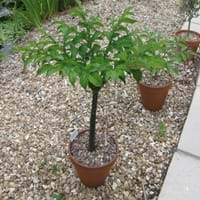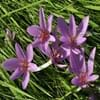Life Span
Perennial
Perennial
Type
Bulb or Corm or Tuber
Perennial
Origin
Hybrid origin
Northeastern United States, Mid-Atlantic United States, Southeastern United States, Central United States, Canada
Types
boissieri , cupanii , hungaricum , kesselringii
Not available
Number of Varieties
Not Available
Habitat
Temperate Regions
Mountain Slopes, subtropical regions, Tropical Climate, Warmer regions
USDA Hardiness Zone
Not Available
4-9
AHS Heat Zone
Not Available
9-1
Sunset Zone
21,22
Not Available
Habit
Clump-Forming
Clump-Forming
Flower Color
Purple, Violet
Yellow, Orange
Flower Color Modifier
Bicolor
Not Available
Fruit Color
Not Available
Not Available
Leaf Color in Spring
Green
Green
Leaf Color in Summer
Light Green
Green
Leaf Color in Fall
Several shades of Green
Green
Leaf Color in Winter
Light Green
Green, Purple
Leaf Shape
Long Linear
bipinnate
Plant Season
Spring, Fall
Spring, Summer, Fall
Sunlight
Full Sun, Partial Sun
Full Sun, Partial Sun, Partial shade
Type of Soil
Loam
Loam, Sand
The pH of Soil
Acidic, Neutral
Acidic, Neutral, Alkaline
Soil Drainage
Well drained
Well drained
Bloom Time
Late Summer, Early Fall
Spring, Late Spring, Early Summer, Summer
Tolerances
Drought
Drought, Salt
Where to Plant?
Ground
Container, Ground, Pot
How to Plant?
Divison, From bulbs, Seedlings
Seedlings, Tuber propagation, Tubers
Plant Maintenance
Medium
Medium
Watering Requirements
Keep ground moist
Requires plenty of water during the growing season, Requires regular watering
In Summer
Lots of watering
Lots of watering
In Spring
Moderate
Moderate
In Winter
Average Water
Average Water
Soil pH
Acidic, Neutral
Acidic, Neutral, Alkaline
Soil Type
Loam
Loam, Sand
Soil Drainage Capacity
Well drained
Well drained
Sun Exposure
Full Sun, Partial Sun
Full Sun, Partial Sun, Partial shade
Pruning
no pruning required
Remove damaged leaves, Remove dead branches, Remove dead leaves
Fertilizers
All-Purpose Liquid Fertilizer
All-Purpose Liquid Fertilizer
Pests and Diseases
Dry root rot, Pest Free
Aphids, Birds
Plant Tolerance
Drought
Drought
Flower Petal Number
Single
Single
Foliage Texture
Coarse
Bold
Foliage Sheen
Glossy
Matte
Attracts
Whiteflies
Birds
Allergy
Poisonous to grazing animals
Diarrhea, Excessive flatus, gastro-intestinal problems
Aesthetic Uses
along a porch, deck or patio, Borders, Mixed Border, small hedge
Not Used For Aesthetic Purpose
Beauty Benefits
No Beauty Benefits
Not Available
Environmental Uses
Air purification
Air purification
Medicinal Uses
anti rheumatic, cathartic
Boils, bowel syndrome, cholesterol-lowering, Colic, Digestive, Fiber, Low calories, Piles, Stimulates new cell growth, Weight management and satiety
Part of Plant Used
Root
Corms, Fibre, Root, Seeds, Tuber
Other Uses
Showy Purposes
Traditional medicine, Used like flour
Used As Indoor Plant
No
No
Used As Outdoor Plant
Yes
Yes
Garden Design
Container, Cutflower, Foundation, Lawns and Turf, Mixed Border
Container, Edible, Feature Plant, Groundcover, Mixed Border, Rock Garden, Wall, Wildflower
Botanical Name
COLCHICUM 'Lilac Wonder'
OPUNTIA humifusa
Common Name
Hybrid Autumn Crocus, Hybrid Meadow Saffron
voodoo lily, snake palm, elephant yam
In Hindi
meadow saffron
Konjac
In German
Herbstzeitlose
Teufelszunge
In French
Colchique d'automne
Amorphophallus konjac
In Spanish
Estado de conservación
Amorphophallus konjac
In Greek
meadow saffron
Konjac
In Portuguese
Colchicum autumnale
Amorphophallus konjac
In Polish
Colchicum autumnale
konjac
In Latin
autumnale
Konjac
Phylum
Tracheophyta
Tracheophyta
Class
Magnoliopsida
Magnoliopsida
Order
Liliales
Alismatales
Genus
Colchicum
Amorphophallus
Clade
Angiosperms, Monocots
Angiosperms, Monocots
Tribe
Not Available
Thomsonieae
Subfamily
Not Available
Aroideae
Number of Species
Not Available
Not Available
Season and Care of Meadow Saffron and Devil's Tongue
Season and care of Meadow Saffron and Devil's Tongue is important to know. While considering everything about Meadow Saffron and Devil's Tongue Care, growing season is an essential factor. Meadow Saffron season is Spring and Fall and Devil's Tongue season is Spring and Fall. The type of soil for Meadow Saffron is Loam and for Devil's Tongue is Loam, Sand while the PH of soil for Meadow Saffron is Acidic, Neutral and for Devil's Tongue is Acidic, Neutral, Alkaline.
Meadow Saffron and Devil's Tongue Physical Information
Meadow Saffron and Devil's Tongue physical information is very important for comparison. Meadow Saffron height is 12.70 cm and width 20.30 cm whereas Devil's Tongue height is 10.20 cm and width 30.00 cm. The color specification of Meadow Saffron and Devil's Tongue are as follows:
Meadow Saffron flower color: Purple and Violet
Meadow Saffron leaf color: Green
Devil's Tongue flower color: Yellow and Orange
- Devil's Tongue leaf color: Green
Care of Meadow Saffron and Devil's Tongue
Care of Meadow Saffron and Devil's Tongue include pruning, fertilizers, watering etc. Meadow Saffron pruning is done no pruning required and Devil's Tongue pruning is done Remove damaged leaves, Remove dead branches and Remove dead leaves. In summer Meadow Saffron needs Lots of watering and in winter, it needs Average Water. Whereas, in summer Devil's Tongue needs Lots of watering and in winter, it needs Average Water.





